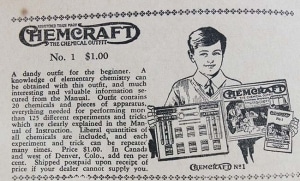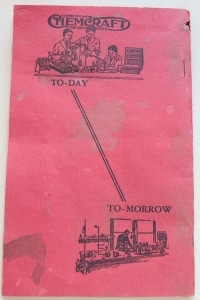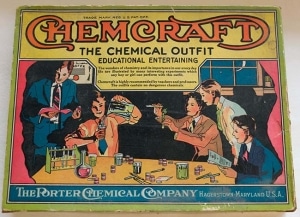 John and Harold Porter created their first chemistry set in 1915 after seeing the popularity of A. C. Gilbert’s Erector Set. In 1920, Gilbert made his Gilbert chemistry outfit, with the clear intention of encouraging boys to become chemists. In the 19th century, chemistry sets were practical kits made for school use. Savvy teachers have known for years that chemistry classes become memorable when a molecule is put in context. For instance, sodium thiosulfate solution can be used to clean and polish silver. Chemistry sets for children focused on applications of science to daily life, adapting as the context changed from the 1920s industrial chemistry to the mid-century atomic energy focus on splitting atoms. Packaging of 1950s chemistry sets featured rockets, submarines, and satellites as science moved from the atomic age to the space age. While the images in advertisements and packaging show children doing experiments, some marketing targeted parents who hoped that their child would become a scientist. Porter Chemcraft sets boasted a tagline, “Experimenter Today … Scientist Tomorrow.”
John and Harold Porter created their first chemistry set in 1915 after seeing the popularity of A. C. Gilbert’s Erector Set. In 1920, Gilbert made his Gilbert chemistry outfit, with the clear intention of encouraging boys to become chemists. In the 19th century, chemistry sets were practical kits made for school use. Savvy teachers have known for years that chemistry classes become memorable when a molecule is put in context. For instance, sodium thiosulfate solution can be used to clean and polish silver. Chemistry sets for children focused on applications of science to daily life, adapting as the context changed from the 1920s industrial chemistry to the mid-century atomic energy focus on splitting atoms. Packaging of 1950s chemistry sets featured rockets, submarines, and satellites as science moved from the atomic age to the space age. While the images in advertisements and packaging show children doing experiments, some marketing targeted parents who hoped that their child would become a scientist. Porter Chemcraft sets boasted a tagline, “Experimenter Today … Scientist Tomorrow.”
A recent acquisition of a 1920s Porter Chemcraft set has a box with colorful illustrations of children playing at experiments with a moon visible through the window. This chemistry set, Number 1 in a series, would have sold for one dollar in the 1920s. The earliest Porter Chemcraft sets were sold in cardboard boxes. Later chemistry sets used wooden or metal cases. Inside the Chemcraft set are glass test tubes, a spoon, stirring rods, and several wood containers with labels describing their contents: sulfur, sodium carbonate, sodium ferrocyanide, aluminum sulfate, tannic acid, sodium thiosulfate, logwood, and powdered iron metal. The accompanying booklet describes experiments “any boy or girl can perform with this outfit.” Children could use the Chemcraft set to make vinegar, use purple hollyhocks as acid-base color indicator, separate gluten from flour, or make magic ink in a Prussian blue color.
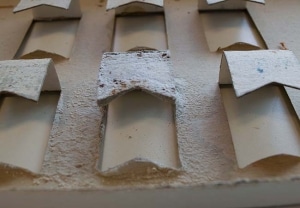 Inside the 1920s Chemcraft set, I found the contents of the small wooden containers swelled with humidity and expanded. The chemicals had spilled inside the cardboard box tray and insert, damaging paper in a variety of ways. Some chemicals reacted with the acidic cardboard, leaving white crystals on the surface and swelling the cardboard to a weak and fragile state. Other chemicals mixed together in the bottom of the box tray, creating an array of colorful stains in brown, black, white, Prussian blue, pale yellow, and rust. Even with the set’s original experiment booklet and some chemistry knowledge, it is hard to guess what has mixed or reacted inside the box. Some of the reactants had turned into their hydrated form after years in humid storage. I considered a matrix of reactions between any of the chemicals with any other chemical in the box.
Inside the 1920s Chemcraft set, I found the contents of the small wooden containers swelled with humidity and expanded. The chemicals had spilled inside the cardboard box tray and insert, damaging paper in a variety of ways. Some chemicals reacted with the acidic cardboard, leaving white crystals on the surface and swelling the cardboard to a weak and fragile state. Other chemicals mixed together in the bottom of the box tray, creating an array of colorful stains in brown, black, white, Prussian blue, pale yellow, and rust. Even with the set’s original experiment booklet and some chemistry knowledge, it is hard to guess what has mixed or reacted inside the box. Some of the reactants had turned into their hydrated form after years in humid storage. I considered a matrix of reactions between any of the chemicals with any other chemical in the box.
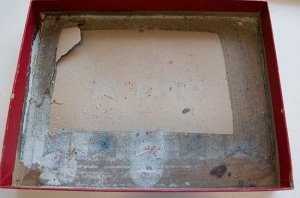 Sodium ferrocyanide in the chemistry set is also known as “Yellow Prussiate of Soda” in older chemical nomenclature, but the contents of the sodium ferrocyanide container have degraded to a faint blue after nearly a century in storage. Ferro cyanides are less toxic than other cyanide groups, but can react with acids to produce toxic cyanide gas. After nearly a hundred years, the cardboard box is deteriorating and acidic. Conservation treatment of the Chemcraft set aims to make the box free of hazards to people, prevent any noxious chemical off-gassing if placed on display, and reduce further chemical degradation of all the contents and the cardboard box. Approaching it with caution, I am slowly cleaning away the stains and chemical residues a little at a time.
Sodium ferrocyanide in the chemistry set is also known as “Yellow Prussiate of Soda” in older chemical nomenclature, but the contents of the sodium ferrocyanide container have degraded to a faint blue after nearly a century in storage. Ferro cyanides are less toxic than other cyanide groups, but can react with acids to produce toxic cyanide gas. After nearly a hundred years, the cardboard box is deteriorating and acidic. Conservation treatment of the Chemcraft set aims to make the box free of hazards to people, prevent any noxious chemical off-gassing if placed on display, and reduce further chemical degradation of all the contents and the cardboard box. Approaching it with caution, I am slowly cleaning away the stains and chemical residues a little at a time.
Today’s young scientist can play with Thames and Kosmos chemistry sets. Some popular science experiments are more impromptu. The Internet has dozens of recipes for “slime,” a product made using easily accessible household chemicals. The polyvinyl acetate and borax gel recipe is similar to recipes for conservation cleaning gels that remove stains from paper. Conservators use gel to suspend a cleaning agent and prevent direct contact of artifacts with water or solvent. Kids use their slimy gels to experiment with mixing ingredients and entertain with sensory play. Elmer’s white glue experienced a shortage last year during the peak of slime-mania. Parents of slime-makers notice their contact lens solution disappear as kids raid the house for slime supplies. Just like experimenters today, the young experimenters of the 1920s probably snuck into the pantry for an egg and vinegar to try Chemcraft’s “Experiment 122: Elastic Eggs.” Experimenting with household chemistry is a timeless way to play.




